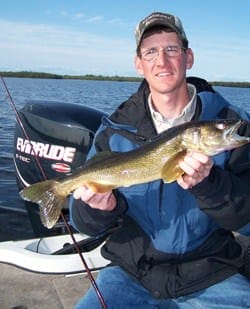
Fifty degree weather, drizzle and receding snow have reminded me that the open water fishing season is fast approaching. Following are some fishing ideas that I am going to be sure to keep in mind when I’m on the water this year.
The first thing is to remember that fish are more likely to feed up than to feed down. They will be more likely to move up for bait than to move down for bait. That’s the way most fish are built. Their eyes are on top of their head, so they can see up better than down. Almost all of the time, it will work better to keep your lure a little above the fish.
With that in mind, remember that when the water is stained or dirty, you’ll want a bait that’s working on the bottom to make noise. Let’s say you’re using a crankbait in dirty water. Select a bait that will pound the bottom. You want it crashing into rocks and logs and grinding into the bottom. It makes more noise that way, so the fish can find your bait easier. We want it to be as easy as possible for the bass or walleyes or any other type of fish to find your bait. And in stained water, noisy bait is easier to find.
When you’re on a spot that’s producing well, but then slows down, try something different. Fish become conditioned to lures and presentations. If you’ve been catching ‘em good on a white jig but the action slows, try a different color jig or a different lure style altogether. Show the fish something different, and they’ll eat it.
If you’re a bass angler, make this the year you use a swimming retrieve with your jigs. Jigs are traditionally a bait that are crawled or hopped along the bottom, but for the past couple of years, I’ve been breaking jigging tradition with great success.
Team a Jungle Jig with a four inch Power Grub or PowerBait Ripple Shad. Instead of crawling it along the bottom, throw it anywhere you’d throw a spinnerbait. Use a straight retrieve, but pause it for just a second when it comes by some cover. In some bodies of water, a swimming jig will be better in spinnerbait water than a spinnerbait.
Pay more attention to your sonar. More and more, anglers are driving around looking at structure with their sonar before wetting a line. If they don’t see fish on the sonar, they keep moving until fish are found. With the side-imaging that Humminbird developed, an angler can look at lots of water very quickly. The more your bait is in productive water, the more fish you’re going to catch.
Last of all, to catch more fish this year, go fishing more often. Wherever you live, there are probably some good fishing opportunities nearby. Get on the water as much as you can and experiment with new techniques or variations of time-tested techniques. If you do, you’re going to catch more fish and enjoy your time on the water even more.
To see the new 2011 episodes of Fishing the Midwest television online, go to fishingthemidwest.com or visit MyOutdoorTv.com







